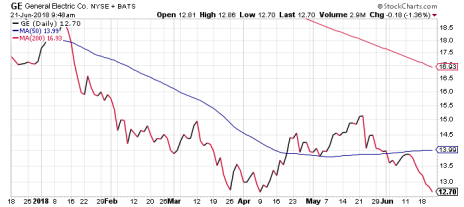On June 19, 2018, investors learned of the historic news that General Electric (GE) stock has lost its position among the 30 corporate heavyweights that make up the Dow Jones Industrial Average stock market index. GE stock was a proud member of the Dow for 111 uninterrupted years.
A variety of factors contributed to this stunning change of events, including the Dow’s lower emphasis on manufacturing companies, GE’s struggling finances and its very low share price. The Dow is a price-weighted index, meaning that a low-priced stock like GE cannot contribute meaningfully to the index’s value.
By replacing GE with a much higher-priced stock, the value of the index can rise more than it would by continuing to hold any low-priced stock, whether that stock belongs to GE or a rapidly growing company. With regard to the index’s price-weighting, a writer for the Financial Times stated, “I have long contended that [the DJIA] is a pointless and mathematically unsound index that measures nothing in particular.”
As a result of the decision to extract GE stock from the Dow, most investment portfolios that purposely focus on Dow stocks will sell GE, causing selling pressure on an already-weak share price. There are approximately $29 billion in investment funds that are tied to the DJIA. Those funds include mutual funds, ETFs, pension funds, business retirement plans, IRA accounts, endowments and more. That’s a lot of potential selling!
GE Stock Worse off than GE the Company
While General Electric stock had become irrelevant to the Dow, the company is not a disaster, and is not losing money, although its debt obligations are forcing painful and regrettable business decisions. While focusing on its power, healthcare and aviation businesses, GE is selling off business units in order to raise money to fund pension liabilities and to maintain its quarterly dividend. GE also owns a majority stake in Baker Hughes (BHGE), a very profitable oilfield service company.
[text_ad]
Wall Street’s consensus earnings estimates project GE’s profits to fall 10.6% in 2018, then rise 10.6% in 2019. The dividend, which was cut in half in late 2017, is yielding 3.7%, and remains at risk of being cut further or eliminated due to the company’s cash needs.
In the last two years, the GE share price has fallen from 31 to 12.50. The price chart remains weak. The stock could fall further and establish a slightly lower trading range, then remain low through year-end due to ongoing business travails and compounded by tax-loss selling.
For investors who are wondering whether this is a good time to bargain hunt and buy GE stock, the answer is a resounding “No!”
Successful portfolio managers focus their bargain hunting among companies with strong finances. GE has unfortunately morphed from an industrial giant to an unfocused corporate entity that has overextended its financial obligations to such a degree that its dividend – and its very existence – remain at significant risk. If you want a stock market bargain, buy a leading company among banks or homebuilders. If you want to gamble, buy a company with aggressive earnings growth and a high P/E. But it makes no sense to bargain hunt with a stock that could very well be terminally ill.
GE Stock Out, WBA Stock In
GE will be replaced in the Dow index by Walgreens Boots Alliance (WBA), an international wholesaler and retailer of health, beauty and pharmaceutical products. Walgreens bought Europe’s Alliance Boots in December 2014.
The company is expected to see earnings per share grow 16.9% in 2018 (August year-end) and 8.7% in 2019. The 2019 P/E is 10.5 and the dividend yield is attractive at 2.3%.
WBA fell from 84 to 62 (a 26% drop) during the last year. After trading in the mid-60s for three months, WBA rose 5% upon news of its inclusion in the Dow index. We could see the stock rise quickly to 70, where it would meet some price resistance and also be fairly valued. The near-term institutional buying could be somewhat offset by unhappy investors selling at a loss as the share price begins to retrace former levels. Nevertheless, I expect a net gain in the share price in the coming months.
WBA does not fit my growth & value equity investment strategy because earnings growth is expected to be moderate in fiscal 2019. If I owned the stock, I’d keep it for now, because barring an unexpected disruption in the stock market, WBA will likely rise. I would instead monitor the price action and use a stop-loss order to protect my downside. Once WBA is done rising in conjunction with its new inclusion in the Dow index, I would sell the stock in favor of an undervalued stock that’s expected to achieve significantly more earnings growth, thus paving the way for additional capital appreciation.
If you do want to find out about other stocks that do fit my investment strategy, consider taking a trial subscription to Cabot Undervalued Stocks Advisor. For a limited time, we have a special offer for new subscribers. Join today and get 14 days free!
[author_ad]

